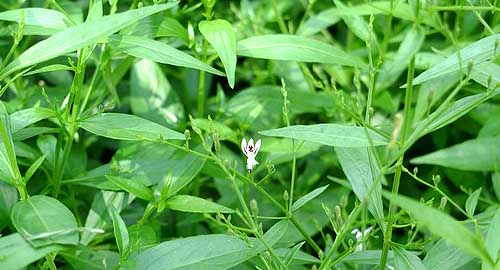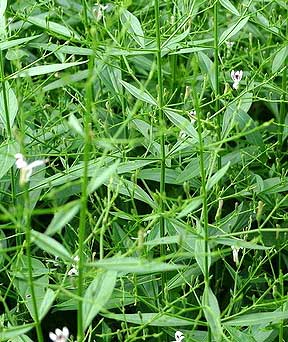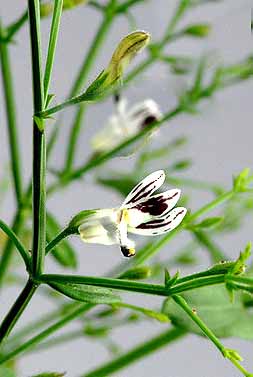Andrographis is an interesting attractive plant that does best in hot humid locations. It loves sunshine and water. It can be grow other hot sunny locations provided it is watered. This annual plant can reach 35-40" in height in one season producing a dark green bush festooned with small white flowers with purple markings. Its not a fussy plant and will grow on almost any soil type as long as its not waterlogged. Once established it takes little or no care and can be left to just be enjoyed throughout the long flowering period. If growing for harvesting good soil and nitrogen fertilizers is recommended. The whole plant is very bitter so its unlikely to be eaten by wildlife but since we grow ours behind a fence we cant say for sure.
Description of Kalmegh (Andrographis paniculata).
An erect branched annual ranging in height from 11" to 35" (0.3-0.9
meters). The plant has square stems with long lanceolate leaves, which have
a sharp point at the outer end, widest in the center and narrow again where
they join to the stem. Usually 2-5" long and ¾ - 1 1/2" wide.
The leaves are arranged alternately on the stem. The plant begins as a dense
clump of mid to dark green leaves but as they grow in height they branch producing
multitudes of flowering stems and leaves appear to become sparser. The flowers
themselves are small tubular at the base with three upright lobes at the top
and a downward facing one at the front. The upright petals are usually spotted
or striped with purple or rose. Each branch produces on a one or two blooms
at once but flowers are produced in profusion from so many branches that there
are always many blooms on each plant. Flowers are followed by long thin seed
pods containing numerous yellow brown seeds. Under idea conditions this plant
can reach the size and dimensions of a small shrub. The whole plant has a bitter
taste due to the pungent chemical compounds and is therefore often known as
"king of bitters".
Growing Kalmegh (Andrographis paniculata) from Seed.
Andrographis has a hard waxy seed coating which allows the seeds to remain viable
for long periods of time in hot climates. However it makes it harder for the
seed to break dormancy. Much research has been done on this plant since it is
so important in Ayurvedic medicine and the consensus is that the seeds should
be soaked in hot water for five minutes before sowing.
The temperature of the water should be around 50°C (122°F) for five
minutes. Do not use boiling water and do not leave the seeds in the hot water
for longer than five minutes or the viability can be decreased. After seeds
have soaked sow them in seed trays or plug trays, see our general
growing instructions for more detailed information on how to do this. When
pots are filled add a thin layer of sand just before seeds are sown to provide
some extra sharpness that will help scratch the tiny seeds outer coating and
aid in germination. Cover seeds with a very thin layer of seeding mix, the seeds
are small and don't like to be buried too deeply. Using this method we have
found we get about an 85% germination rate on our seeds. Without this germination
can be erratic and as low as 20%. Germination takes about 5-7 days using this
method.
Location and Care of Kalmegh (Andrographis paniculata).
Andrographis is native to India and Pakistan so it likes hot humid weather and
is therefore an excellent garden plant especially in the south eastern region
of the united states. This plant will not do well in cooler regions but if your
summers are hot it should grow well. In dryer areas more watering may be required
and some shade provided for the main part of the day.
While this plant really likes sunshine research studies in India have shown
that it grows most prolifically is given some shade so in hot sunnier areas
pick a location where there is some shade during the hottest part of the day.
Andrographis is not really fussy about soil type but it does need to be well drained, it will not survive in wet or waterlogged soils. It also seems to prefer some sand in the soil, but provided there is enough organic material to ensure good drainage this should not be necessary. A soil with good organic material will produce the biggest lushes plants and if growing for medicinal harvest plenty of organic material and nitrogen fertilizer is recommended to produce lush leaves and larger plants.
Water plants after
planting out until they start to grow well and become
established. Continued watering will depend on your location, if there is sufficient
rainfall little or no extra will be needed, if planted in a dryer location or
there is a period of no rain then extra watering will be required to keep the
plants lush and growing. If insufficient water the lower leaves tend to yellow
and fall off.
Once established andrographis is a very unfussy plant and takes little care
and attention. It is extremely undemanding plant.
Spacing. Will really depend on your location. In good hot humid conditions with rich well drained soil this plant can reach 3 feet in height and similar spread, thus plants will need to be father apart, in less ideal conditions it may only reach 18". Commercially this plant is usually planted around 22" apart (60cm). If unsure of your results plant slightly closer together and remove some plants if they grow too large and overcrowd each other.
Harvesting of Kalmegh (Andrographis paniculata).
The whole above ground plant should be harvested when flower begin to cover
the plant, this is when the plant is producing the highest concentration of
the principal andrographolide. Plants can then be dried for later use. Research
studies have shown that there is more biomass on plants that are given some
shade than those that are grown in full sunshine. In addition if plants have
their tips cut off at about 6 weeks after transplanting it caused more branching
leading to larger bushier plants that provided more biomass.
Medical uses of Kalmegh (Andrographis paniculata).
Andrographis it a bitter that has a very long history of being used in Ayurvedic
and Chinese herbal medicine. Most commonly it is used to treat colds, flu and
fevers. It aids in preventing infections of the rhinoviruses that are mostly
responsible for the common cold. Studies have shown that taking andrographis
daily during cold season reduced the likelihood of catching a cold by 50%. It
can also be used to treat cold symptoms but needs to be in fairly high doses
to be effective.
It is also used to treat intestinal disorders, diarrhea, intestinal parasites,
wounds, ulcers, inflammations, skin diseases, hepatitis, and problems related
to the liver and gall bladder by helping increase bile flow. There is also some
research supporting its use treating the symptoms of HIV and some cancers.
By far the most significant use is in the treatment of atherosclerosis and heart
attack. Andrographis has the ability to prevent the formation of blood clots
and help prevent "re-clogging" of arteries following angioplasty by
helping the vessels stay open for longer periods of time.
Other names.
King of bitters, Kalmegh,








